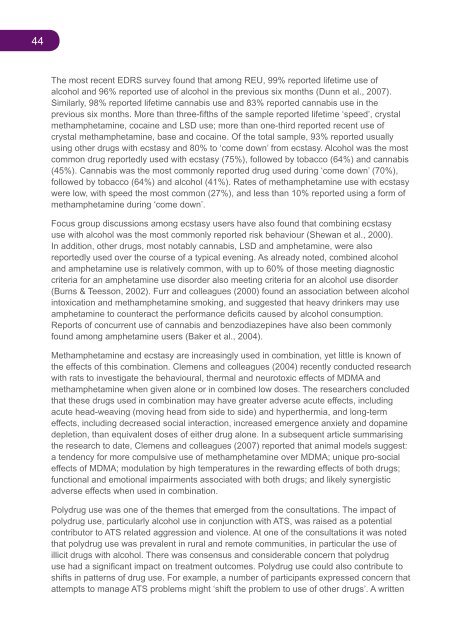National Amphetamine-Type Stimulant Strategy Background Paper
National Amphetamine-Type Stimulant Strategy Background Paper
National Amphetamine-Type Stimulant Strategy Background Paper
You also want an ePaper? Increase the reach of your titles
YUMPU automatically turns print PDFs into web optimized ePapers that Google loves.
44<br />
The most recent EDRS survey found that among REU, 99% reported lifetime use of<br />
alcohol and 96% reported use of alcohol in the previous six months (Dunn et al., 2007).<br />
Similarly, 98% reported lifetime cannabis use and 83% reported cannabis use in the<br />
previous six months. More than three-fifths of the sample reported lifetime ‘speed’, crystal<br />
methamphetamine, cocaine and LSD use; more than one-third reported recent use of<br />
crystal methamphetamine, base and cocaine. Of the total sample, 93% reported usually<br />
using other drugs with ecstasy and 80% to ‘come down’ from ecstasy. Alcohol was the most<br />
common drug reportedly used with ecstasy (75%), followed by tobacco (64%) and cannabis<br />
(45%). Cannabis was the most commonly reported drug used during ‘come down’ (70%),<br />
followed by tobacco (64%) and alcohol (41%). Rates of methamphetamine use with ecstasy<br />
were low, with speed the most common (27%), and less than 10% reported using a form of<br />
methamphetamine during ‘come down’.<br />
Focus group discussions among ecstasy users have also found that combining ecstasy<br />
use with alcohol was the most commonly reported risk behaviour (Shewan et al., 2000).<br />
In addition, other drugs, most notably cannabis, LSD and amphetamine, were also<br />
reportedly used over the course of a typical evening. As already noted, combined alcohol<br />
and amphetamine use is relatively common, with up to 60% of those meeting diagnostic<br />
criteria for an amphetamine use disorder also meeting criteria for an alcohol use disorder<br />
(Burns & Teesson, 2002). Furr and colleagues (2000) found an association between alcohol<br />
intoxication and methamphetamine smoking, and suggested that heavy drinkers may use<br />
amphetamine to counteract the performance deficits caused by alcohol consumption.<br />
Reports of concurrent use of cannabis and benzodiazepines have also been commonly<br />
found among amphetamine users (Baker et al., 2004).<br />
Methamphetamine and ecstasy are increasingly used in combination, yet little is known of<br />
the effects of this combination. Clemens and colleagues (2004) recently conducted research<br />
with rats to investigate the behavioural, thermal and neurotoxic effects of MDMA and<br />
methamphetamine when given alone or in combined low doses. The researchers concluded<br />
that these drugs used in combination may have greater adverse acute effects, including<br />
acute head-weaving (moving head from side to side) and hyperthermia, and long-term<br />
effects, including decreased social interaction, increased emergence anxiety and dopamine<br />
depletion, than equivalent doses of either drug alone. In a subsequent article summarising<br />
the research to date, Clemens and colleagues (2007) reported that animal models suggest:<br />
a tendency for more compulsive use of methamphetamine over MDMA; unique pro-social<br />
effects of MDMA; modulation by high temperatures in the rewarding effects of both drugs;<br />
functional and emotional impairments associated with both drugs; and likely synergistic<br />
adverse effects when used in combination.<br />
Polydrug use was one of the themes that emerged from the consultations. The impact of<br />
polydrug use, particularly alcohol use in conjunction with ATS, was raised as a potential<br />
contributor to ATS related aggression and violence. At one of the consultations it was noted<br />
that polydrug use was prevalent in rural and remote communities, in particular the use of<br />
illicit drugs with alcohol. There was consensus and considerable concern that polydrug<br />
use had a significant impact on treatment outcomes. Polydrug use could also contribute to<br />
shifts in patterns of drug use. For example, a number of participants expressed concern that<br />
attempts to manage ATS problems might ‘shift the problem to use of other drugs’. A written

















